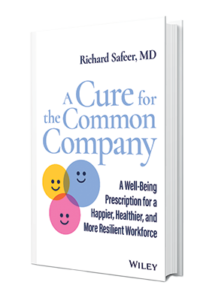Every Wegmans store has Robert B. Wegman’s photograph with his credo: “Never think about yourself; always help others.” What a great world it would be if we all lived by that mantra!
For Wegmans, this isn’t just a quote, it’s a shared value. It’s a value they strive to instill in every interaction both internally and externally. Is it any surprise then that Wegmans has been on the list of Fortune magazine’s 100 Best Companies to Work For every one of the 24 years the ranking has been made available?
If it were only so easy to articulate a great commitment that supports both employees and customers and then have it come to fruition.
Companies like Zappos work hard and are very intentional in shaping their core values. “Create Fun and a Little Weirdness” and “Build a Positive Team and Family Spirit” are just two of their ten core values that clearly support well-being. Zappos builds cultural fit into their interview process and once onboard, there is a training team to impart wisdom about each core value. The result? Zappos is frequently seen on the list of Fortune 100 Best Companies to Work For1.
Are you getting the picture? Shared values matter. But it’s unusual for a company to put optimal employee health and well-being on the high-priority list, alongside goals like profitability, outstanding customer service, and product innovation. However, we have clear evidence that a culture that puts employee wellbeing at the top, starting with its values, will create success.
Every organization has a set of values whether those are officially recognized or not. Some could be linked to the business objectives, work ethics, or brand characteristics. Some may be publicly stated while others are intuitively understood.
These shared values have a crucial role to play in employee health. They can influence how well the organization will support a culture of well-being (or frankly, manage affairs contrary to this goal). Unfortunately, most company values, unlike that of Wegmans and Zappos, are tied more closely to productivity, sales, and conquering the competition.
Workers want employee-oriented shared values that promote their health and well-being. And no, more pay won’t compensate for undesirable workplace cultures. A LinkedIn survey2 found that 65 percent of employees would tolerate a lower pay than suffer a bad workplace environment. Even business leaders know the results of unhealthy values. According to the National Bureau of Economic Research3, nearly 85 percent of CFOs and CEOs are aware that unhealthy cultures can create unethical behaviors.
We have clear evidence that a culture that puts employee well-being at the top will be both sustainable and successful. For a workplace culture of health to flourish, it needs to be prioritized, like other business objectives, and included in the organizational values.
In other words, shared values centered around employee health and well-being shouldn’t be what grows and takes root in the system outside of management’s influence. They should be proactively identified, communicated, nurtured, and managed by everyone from C-suite leaders to team managers and HR teams.
If your organization doesn’t have a shared vision that values a healthy workforce, it’s time to create one. One way to do so is by aligning it with your organization’s history or business objectives. Your workforce is more likely to believe in it and your internal systems would be more encouraged to support it if they know that it’s organically rooted in your organization.
Regardless of whether you’re able to find a connection between your company’s origin and the value of health and wellbeing, these are some tips for creating the values:
- The values should be easily remembered and therefore easily repeated.
- They should resonate with everyone at some level, making it easy to turn to them for direction and inspiration.
- They should be tailored to the organization’s language and traditions.
- To be meaningful to the organization, the shared values should be tied to the business case for pursuing well-being at the workplace. Your shared values will have more impact if they support the mission of the organization.
Workplaces that prioritize employee health and well-being include it as a shared value. There are five other building blocks in addition to shared values, that contribute to a healthy and well workplace culture. Next week we’ll explore leadership engagement.
Until then, what shared values does your company have that support employee health and wellbeing? Send me a message on LinkedIn or at RichardSafeer.com. Maybe I’ll feature your company as an example later in 2023.
1 Thebalancecareers.com/zappos-company-culture-1918813.
2 Workplace Culture Trends: The Key to Hiring (and Keeping) Top Talent in 2018
3 Corporate Culture: Evidence from the Field, John R. Graham, Campbell R. Harvey, Jillian Popadak & Shivaram Rajgopal


